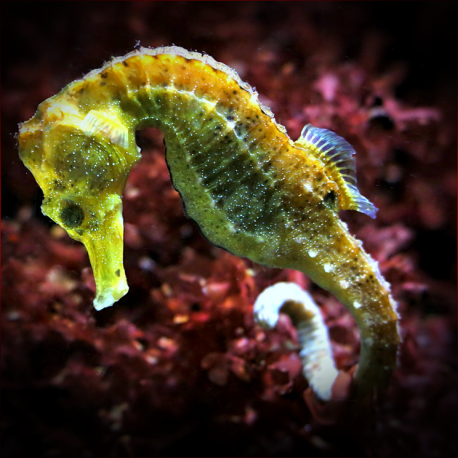More info
Datasheet
| Minimum Tank Size | 207 litres / 54.68 US gallons |
| Maximum Size | 17.8cm / 7.01inches |
| Reef Compatible | Yes |
| Temperament | Peaceful |
| Care Description | Moderate |
| Water Flow | Low to Medium |
| Specific Gravity | 1.021-1.025 |
| Carbonate Hardness | 8-12 |
| pH | 8.0-8.4 |
General Description
The Reidi Seahorse, also known as the Longsnout Seahorse, belongs to the species Hippocampus reidi and is a captivating marine fish found in the Western Caribbean. It is available in color variants of Yellow or Black, with its coloration often adapting to its environment.
Aquarium Suitability
The Reidi Seahorse is best kept as a mated pair or in a small group in a species-only aquarium of 30 gallons or larger. It thrives in tanks with a height of at least 16 inches to ensure adequate circulation. Peaceful companions like gobies, ocellaris and percula clowns, and firefish are suitable tank mates, while aggressive or fast-moving fish should be avoided.
Demands, Care, and Hardiness
Reidi Seahorses have moderate care requirements and do well with a diet of frozen mysis shrimp, live saltwater feeder shrimp, amphipods, and other small crustaceans found in live rock. They prefer multiple small feedings per day and are outcompeted by faster fish for food. With a peaceful temperament, they spend their time clinging to seagrass using their prehensile tails.
Reef Suitability
Being reef-compatible, Reidi Seahorses can be housed in reef aquariums without posing a threat to corals or other invertebrates.
Aquarium Setup
For an aquarium housing Reidi Seahorses, a minimum tank size of 30 gallons (207 litres) is advised. A taller tank with a height of at least 16 inches is preferred for better water flow. Maintaining low to medium water flow and water conditions with pH levels of 8.0-8.4, a specific gravity of 1.021-1.025, and a carbonate hardness (KH) of 8-12 is essential for their well-being.
Behaviour
Male Reidi Seahorses exhibit impressive color changes and energetic pouch displays when ready to mate. They engage in graceful dancing to court females, which can lead to the female depositing up to 600 eggs in the male's pouch. Approximately 14 days later, the male gives birth to miniature replicas of the pair.
Feeding and Diet
Reidi Seahorses are carnivores and feed on a variety of foods, including frozen mysis shrimp, live saltwater feeder shrimp, amphipods, and adult brine shrimp enriched with vitamins. Their slow and deliberate feeding nature necessitates multiple small feedings throughout the day.
Dimorphism and Captive Reproduction
In terms of dimorphism, male and female Reidi Seahorses show differences during courtship and mating behaviors. Captive reproduction of Reidi Seahorses involves courtship rituals where males showcase color changes and energetic displays to attract females, leading to successful reproduction within aquarium settings.
Habitat and Distribution
Hippocampus reidi, the Reidi Seahorse, is predominantly found in the Western Caribbean, inhabiting areas with seagrass where they can cling using their prehensile tails. Their captivating features and unique habits make them a spectacular addition to home aquariums.

